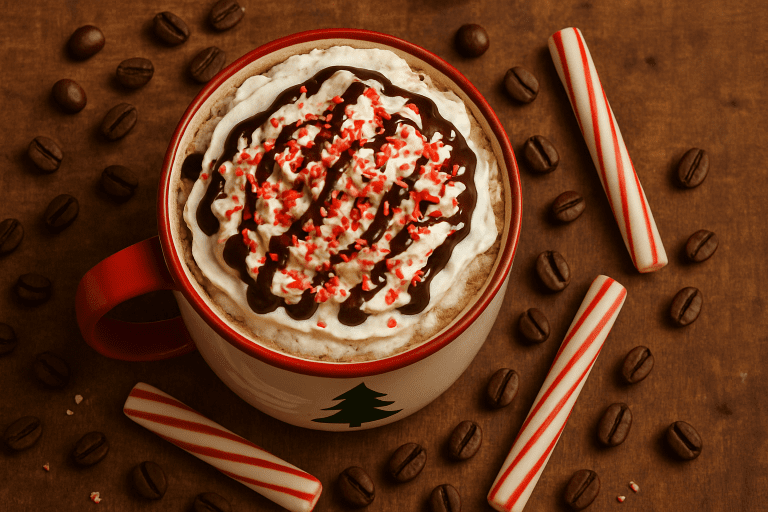
You’re standing at your favorite coffee shop, scanning the menu, and there they are again—cappuccino and café latte. Both sound delicious and contain espresso and milk, but which one should you order? The cappuccino vs. cafe latte debate has puzzled coffee enthusiasts for decades, and today, we’re going to clear up the confusion once and for all. We’ll also provide some tips on how to order these drinks to ensure you get exactly what you’re looking for.
Understanding the differences between these two beloved coffee drinks will transform your coffee ordering experience and help you discover which truly matches your taste preferences. Whether you’re a coffee newcomer or have been drinking the same order for years, this guide will give you the confidence to explore and appreciate what makes each drink special.
A beautifully crafted cappuccino or café latte in a white cup with intricate latte art.
What is a Cappuccino
A cappuccino is Italy’s gift to the coffee world – a perfectly balanced espresso-based drink that follows the sacred 1:1:1 ratio. This means equal parts espresso, steamed milk, and luxurious milk foam combine to create something truly special. When you order a cappuccino, you get a drink that’s been perfected over centuries.
The magic of a cappuccino lies in its distinct layers. At the bottom sits your bold espresso shot, providing that rich coffee foundation. Above that, steamed milk is heated to the perfect temperature between 60 ° and 70°. Finally, crowning your drink is a thick, airy layer of milk foam that typically measures about 1.5-2 centimeters high.
What makes cappuccinos particularly interesting is their size. They are traditionally served in smaller 5-6 ounce cups, and this isn’t by accident. The smaller serving size ensures that every sip delivers the intended intensity and allows you to taste each component distinctly. You’ll notice that the foam acts as insulation, keeping your drink warmer for longer.
The cappuccino’s name comes from an unexpected source—Capuchin monks and their distinctive brown hooded robes. When coffee met milk in 17th-century Italy, the resulting brown color reminded people of those monks’ habits, and the name stuck. How a religious order influenced your morning coffee routine is fascinating, right?
What is a Café Latte
Let’s talk about the café latte, which translates to “coffee with milk” in Italian. The concept of coffee with milk has been around for centuries, but the modern latte, as we know it, gained popularity in America during the 1980s. It became the perfect bridge between traditional Italian espresso culture and American preferences for milder, larger coffee drinks.
A professionally presented café latte with heart-shaped latte art, alongside brownies and coffee beans.
When you order a latte, you get significantly more steamed milk and a thin layer of microfoam on top, usually about 5 millimeters. This creates an entirely different drinking experience compared to cappuccinos. The increased milk volume makes lattes sweeter and milder, as the steaming process draws out milk’s natural sugars.
Lattes are typically served in larger 8-12 ounce cups or tall glasses. This larger size accommodates the generous amount of steamed milk while maintaining the drink’s intended flavor profile. You’ll often see lattes in tall, clear glasses showcasing the beautiful coffee and milk blend. The history of lattes is quite interesting, too. While coffee with milk existed for centuries, the modern latte gained popularity in America during the 1980s. It became the perfect bridge between traditional Italian espresso culture and American preferences for milder, larger coffee drinks.
Key Differences Between Cappuccino and Café Latte
Let’s compare cappuccino and café latte with details about your coffee experience. The most fundamental difference lies in their milk-to-foam ratios, which create completely different textures and flavors.
Visual comparison of cappuccino vs cafe latte composition ratios
Milk Ratios and Composition
The composition differences between these drinks are striking. Cappuccinos maintain the traditional 1:1:1 ratio—one part espresso (30ml), one part steamed milk (60ml), and one part foam (60ml). This balanced ratio creates a drink with a strong coffee flavor and a thick, substantial texture. Lattes, however, use a 1:2 ratio with one part espresso (30ml) to two parts steamed milk (200ml), topped with just a thin layer of microfoam. This higher milk content results in a milder, sweeter coffee experience with a smoother, more liquid texture.
Serving Sizes and Presentation
Size matters when comparing cappuccino and café latte options. Traditional cappuccinos are served in 150- 180ml cups, while lattes typically come in 240- 360ml glasses. This size difference isn’t arbitrary—it directly impacts how you experience each drink’s flavor intensity and temperature retention.
Calorie and Nutritional Differences
Here’s where things get interesting for health-conscious coffee drinkers. An 8-ounce cappuccino contains approximately 74-130 calories, while the same-size latte packs about 190-210 calories. The latte has over 60% more calories due to the higher milk content. Both drinks contain identical caffeine levels since they use the same amount of espresso.
Taste and Texture Comparison
Understanding the taste differences in the cappuccino vs cafe latte debate will help you make better choices. These drinks offer distinct sensory experiences that appeal to different preferences and moods.
A light blue mug holds a coffee beverage with a distinct spiral pattern of foamed milk and coffee.
Flavor Profiles
Cappuccinos deliver a stronger, more pronounced coffee flavor. The equal-parts formula means the espresso isn’t diluted as much, allowing its bold character to shine. You’ll taste distinct layers as you drink—first the foam, then the marriage of milk and espresso. This layered experience makes cappuccinos special, engaging all your senses in a single sip.
Lattes offer a milder, sweeter coffee experience. The higher milk content creates a naturally sweeter drink because steaming brings out milk’s inherent sugars. If straight espresso is too intense, lattes provide the perfect middle ground.
Texture Differences
The texture contrast between a cappuccino and a ccafélatte is immediately noticeable. Due to their generous foam layer, cappuccinos feel thicker and more substantial. Each sip includes airy foam that dissolves on your tongue, creating a luxurious mouthfeel.
Lattes feel smoother and more liquid. The microfoam blends seamlessly with the steamed milk, creating a velvety texture without the distinct foam layer. This consistency makes lattes feel like drinking an exceptional milky coffee rather than experiencing distinct layers.
Making Cappuccino vs Café Latte at Home
Ready to master the preparation of cappuccino and café latte at home? Both drinks require similar equipment but different techniques. For best results, you’ll need an espresso machine with a steam wand, a milk pitcher, and a thermometer.
A barista pours steamed milk, creating intricate latte art in a white coffee cup.
Cappuccino Preparation Steps
Start by directly pulling your espresso into your serving cup. While the espresso is extracting, fill your milk pitcher about one-third, allowing the milk to expand during frothing. Insert the steam wand just under the milk’s surface and turn on the steam.
The perfect cappuccino foam is determined by timing and technique. Keep the wand tip near the surface for the first few seconds to create foam, then lower it deeper to heat the milk. You want the milk to reach 60-70°C and roughly double in volume. Turn off the steam before removing the wand to avoid sputtering.
Give the milk pitcher a gentle tap to break large bubbles, then swirl lightly. Pour the milk from a low height, finishing with a slight wiggle to ensure the foam transfers to your cup. A perfect cappuccino should have distinct layers visible from the side.
Latte Preparation Techniques
Latte preparation differs mainly in the milk-texturing approach. You’ll still pull the same espresso shot, but your milk technique focuses on creating microfoam rather than thick foam. Start with more milk in your pitcher since lattes require a higher milk-to-coffee ratio.
Keep the wand deeper in the milk from the beginning. When steaming milk for lattes, you want to create a velvety microfoam that’s almost paint-like in consistency. The goal is smooth, integrated foam rather than the thick, airy foam used in cappuccinos.
Pour your latte by starting high to break through the espresso’s surface, bringing the pitcher closer to create any desired latte art. The higher milk volume in lattes makes them more forgiving for beginners attempting latte art.
Which Should You Choose
The cappuccino vs cafe latte decision ultimately comes down to your personal preferences and the experience you’re seeking. Let’s explore when each drink shines brightest to help you make the perfect choice.
Choose a cappuccino when you want to taste the coffee. If you appreciate espresso’s bold flavors but enjoy the smoothness of milk, cappuccinos offer that perfect balance. They’re ideal for morning consumption when you want something substantial but not too heavy. The smaller serving size makes them perfect for a quick coffee break or after-meal enjoyment.
Opt for a latte when you prefer milder coffee flavors. Lattes work wonderfully when you want something comforting and smooth, almost like a warm coffee-flavored hug in a cup. They’re perfect any time of day and provide more flexibility for flavor additions like vanilla or caramel syrups. The larger serving size makes them ideal when you want to savor your coffee over a more extended period.
Consider your calorie goals, too. If you’re watching your intake, cappuccinos offer a more calorie-friendly option while still providing that rich coffee experience. For those who don’t mind the extra calories and prefer creamier textures, lattes deliver that indulgent feeling.
Common Mistakes to Avoid
Understanding common pitfalls in the cappuccino vs cafe latte preparation process will help you achieve better results at home. Even experienced coffee enthusiasts make these mistakes, so don’t worry if you recognize yourself in some of these scenarios.
The biggest mistake people make is getting the milk temperature wrong. Overheating milk above 70°C destroys its natural sweetness and creates a burnt taste that ruins cappuccinos and lattes. Invest in a good thermometer or learn to judge temperature by touch – it’s ready when you can’t hold the pitcher for more than two seconds.
Another standard error is using the wrong milk-to-foam ratios. Many beginners create too much foam for lattes or insufficient foam for cappuccinos, fundamentally changing the drink’s character. Remember, cappuccino vs. cafe latte preparation requires different foaming techniques for different results.
Poor pouring technique ruins even perfectly steamed milk. Starting too high causes milk to sink under the espresso instead of sitting on top. Keep your pitcher close to the cup’s surface throughout the pour for both drinks. For cappuccinos, end with a wiggle to transfer foam; for lattes, focus on smooth, steady pouring.
Another oversight is not stirring the espresso’s crema before adding milk. A quick swirl creates a smoother canvas for your milk and prevents the crema from creating uneven surfaces that affect the final appearance.
Your Perfect Coffee Choice
The cappuccino vs cafe latte decision doesn’t have to be permanent. Many coffee lovers enjoy both drinks for different occasions and moods. Cappuccinos excel when you want to experience coffee’s full character with just enough milk to smooth the edges. Lattes shine when you crave something comforting and accessible, perfect for leisurely sipping.
Both drinks offer unique pleasures and deserve a place in any coffee lover’s repertoire. Whether you choose the bold, layered experience of a cappuccino or the smooth comfort of a latte, you’re participating in centuries of coffee tradition. The beauty of the cappuccino vs. cafe latte comparison lies not in finding a winner but in appreciating what makes each drink special in its own right.
Next time you’re at the coffee counter, you’ll know what distinguishes these two classics. Choose based on your mood, your taste preferences, and the coffee experience you want. After all, the best coffee drink is the one that brings you joy with every sip.

